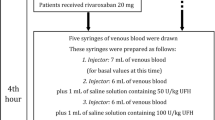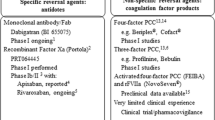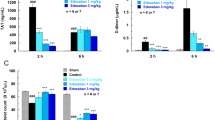Abstract
In recent years, oral factor Xa inhibitors have become a research focus as anticoagulant drugs. Zifaxaban is the first oral FXa inhibitor to enter clinical trials in China. The aim of this study was to determine the inhibitory effect of zifaxaban on thrombosisthrough a model ofinferior vena cava (IVC) thrombosis in rabbits. IVC thrombosis model was established by electrical injury and stenosis, and zifaxaban was administered (p.o.) for 5 consecutive days, then coagulation indicators and bleeding were observed. The results showed that zifaxaban had obvious inhibitory effects on FXa, and had a significant inhibitory effect on IVC thrombosis induced by electrical damage and stenosis. The effect of zifaxaban was similar to that of rivaroxaban, but the bleeding side-effects of zifaxaban were less severe than those of rivaroxaban. Zifaxaban could prolong the prothrombin time and activated partial thromboplastin time of plasma similar to that of other oral FXa inhibitors. Zifaxaban had a significant inhibitory effect on FXa, but it had no obvious effect on other coagulation factors, major anticoagulant factors or fibrinolytic indices. Our results suggest that zifaxaban had specific inhibitory effects on FXa and inhibited IVC thrombosis in rabbits with its hemorrhagic effect was less than that of rivaroxaban. Zifaxaban is ecpected to be developed as a new drug for the prevention of deep venous thrombosis, providing more medication options for patients with such disease, more research is required to support it in the future.




Similar content being viewed by others
References
Turpie AG, Esmon C (2011) Venous and arterial thrombosis–pathogenesis and the rationale for anticoagulation. Thromb Haemost 105(4):586–596
Rico JIA, Pitarch JVL, Rocha E (2010) Overview of venous thromboembolism. Drugs 70(2 Suppl):3–10
Popuri RK, Vedantham S (2011) The role of thrombolysis in the clinical management of deep vein thrombosis. Arterioscler Thromb Vasc Biol 31(3):479–484
Colwell CW Jr (2007) Rationale for thromboprophylaxis in lower joint arthroplasty. Am J Orthop (Belle Mead NJ) 36(9 Suppl):11–13
Kearon C, Akl EA, Comerota AJ et al (2012) Antithrombotic therapy for VTE disease: antithrombotic therapy and prevention of thrombosis, 9th ed: American College of chest physicians evidence-based clinical practice guidelines. Chest 141(2 Suppl):e419S–e496S
Agnelli G, Becattini C, Franco L (2013) New oral anticoagulants for the treatment of venous thromboembolism. Best Pract Res Clin Haematol 26(2):151–161
Rico JIA, Pitarch JVL, Fernandez JAP (2010) Topical issues in venous thromboembolism. Drugs 70(2 Suppl):11–18
Hwang HG, Koo SM, Uh ST et al (2017) The perioperative management of antithrombotic therapies using enoxaparin. J Korean Med Sci 32(6):942–947
Nafee T, Aslam A, Chi G et al (2017) Andexanet alfa for the reversal of anticoagulant activity in patients treated with direct and indirect factor Xa inhibitors. Expert Rev Cardiovasc Ther 15(4):237–245
Kaatz S, Bhansali H, Gibbs J et al (2017) Reversing factor Xa inhibitors—clinical utility of andexanet alfa. J Blood Med 8:141–149
Fujimoto T, Imaeda Y, Konishi N et al (2010) Discovery of a tetrahydropyrimidin-2(1H)-one derivative (TAK-442) as a potent, selective, and orally active factor Xa inhibitor. J Med Chem 53(9):3517–3531
Samama MM (2011) The mechanism of action of rivaroxaban—an oral, direct Factor Xa inhibitor—compared with other anticoagulants. Thromb Res 127(6):497–504
Perzborn E, Strassburger J, Wilmen A, Pohlmann J et al (2010) In vitro and in vivo studies of the novel antithrombotic agent BAY 59-7939—an oral, direct factor Xa inhibitor. J Thromb Haemost 3:514–521
Wong PC, Crain EJ, Xin B et al (2008) Apixaban, an oral, direct and highly selective factor Xa inhibitor: in vitro, antithrombotic and antihemostatic studies. J Thromb Haemost 6(5):820–829
Iwatsuki Y, Sato T, Moritani Y et al (2011) Biochemical and pharmacological profile of darexaban, an oral direct factor Xa inhibitor. Eur J Pharmacol 673(1–3):49–55
Hu X, Xiao Y, Yu C et al (2018) Characterization of a novel selective factor Xa inhibitor, DJT06001, which reduces thrombus formation with low risk of bleeding. Eur J Pharmacol 825:85–91
Virchow RC (2006) Report on the typhus epidemic in upper silesia. Am J Public Health 96(12):2102–2105
Byrnes JR, Wolberg AS (2017) New findings on venous thrombogenesis. Hamostaseologie 37(1):25–35
Keller K, Prochaska JH, Coldewey M et al (2015) History of deep vein thrombosis is a discriminator for concomitant atrial fibrillation in pulmonary embolism. Thromb Res 136(5):899–906
Diaz JA, Obi AT, Myers DD Jr et al (2012) Critical review of mouse models of venous thrombosis. Arterioscler Thromb Vasc Biol 32(3):556–562
Grover SP, Evans CE, Patel AS et al (2016) Assessment of venous thrombosis in animal models. Arterioscler Thromb Vasc Biol 36(2):245–252
Albadawi H, Witting AA, Pershad Y et al (2017) Animal models of venous thrombosis. Cardiovasc Diagn Ther 7(Suppl 3):S197–S206
Diaz JA, Alvarado CM, Wrobleski SK et al (2013) The electrolytic inferior vena cava model (EIM) to study thrombogenesis and thrombus resolution with continuous blood flow in the mouse. Thromb Haemost 109(6):1158–1169
Diaz JA, Wrobleski SK, Hawley AE et al (2011) Electrolytic inferior vena cava model (EIM) of venous thrombosis. J Vis Exp 12(53):e2737
Lip GY, Pan X, Kamble S et al (2016) Major bleeding risk among non-valvular atrial fibrillation patients initiated on apixaban, dabigatran, rivaroxaban or warfarin: a “real-world” observational study in the United States. Int J Clin Pract 70(9):752–763
Norby FL, Bengtson LGS, Lutsey PL et al (2017) Comparative effectiveness of rivaroxaban versus warfarin or dabigatran for the treatment of patients with non-valvular atrial fibrillation. BMC Cardiovasc Disord 17(1):238
Mueck W, Stampfuss J, Kubitza D et al (2014) Clinical pharmacokinetic and pharmacodynamic profile of rivaroxaban. Clin Pharmacokinet 53(1):1–16
Wong PC, Pinto DJ, Zhang D (2011) Preclinical discovery of apixaban, a direct and orally bioavailable factor Xa inhibitor. J Thromb Thromb 31(4):478–492
Funding
This study was supported by the Special Program of Talents Development for Excellent Youth Scholars in Tianjin (TJTZJH-QNBJRC-2-7).
Author information
Authors and Affiliations
Corresponding author
Ethics declarations
Conflict of interest
The authors declare that they have no conflict of interest.
Ethical approval
All applicable international, national, and/or institutional guidelines for the care and use of animals were followed. All procedures performed in studies involving animals were in accordance with the ethical standards of the institution or practice at which the studies were conducted.
Rights and permissions
About this article
Cite this article
Qiu, X., Zhou, J., Wang, W. et al. Effect of a new inhibitor of factor Xa zifaxaban, on thrombosis in the inferior vena cava in rabbits. J Thromb Thrombolysis 47, 80–86 (2019). https://doi.org/10.1007/s11239-018-1743-x
Published:
Issue Date:
DOI: https://doi.org/10.1007/s11239-018-1743-x




